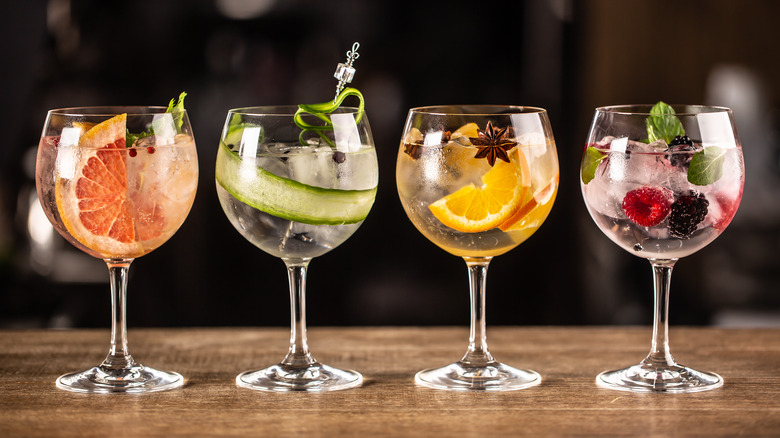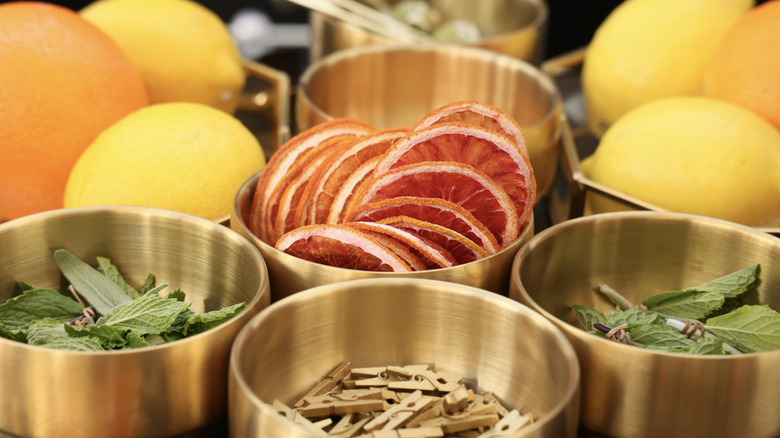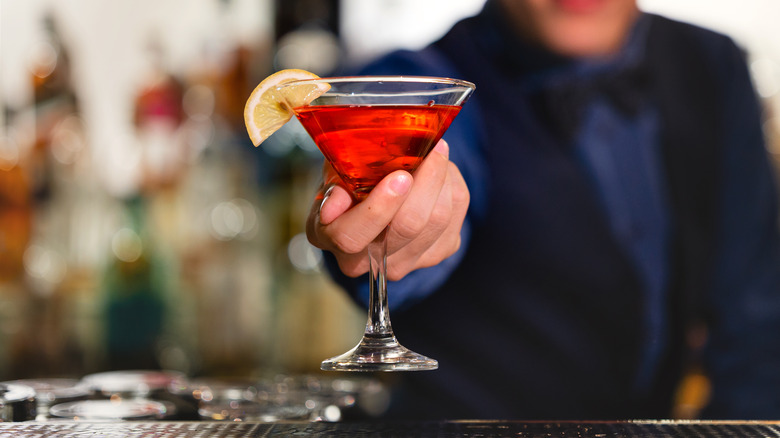How Cocktail Garnishes Are Driving The Food Waste Conversation
Has your local watering hole switched to paper or bamboo straws? While this is certainly a stride in reducing waste (even if they really don't work in frozen drinks), what about the limes at the bottom of every cocktail glass that get tossed into the trash?
The FDA estimates that 30%-40% of the U.S.'s total food supply ends up in landfills. Globally, consumers waste 2.5 billion tons of food every single year, with the U.S. alone contributing 60 million tons and roughly $218 billion wasted along with it. For bars, garnishes thrown in the trash equal money down the drain.
According to Calum Fraser of Discarded Spirits Co., "One kilo of waste from lemon garnishes amounts to about the same carbon emissions as a 20-minute journey in a car," via Food & Wine. One kilo is the equivalent of just 32 lemon wedges. But, how big of a difference can a few fruit peels really make? There are well over 10,000 bars in the U.S., and those garnishes add up quickly. That's before you even factor in the carbon emissions required to transport fruit from wherever it's grown to all of the bars around the world. Those throw-away cocktail garnishes quickly add up to a much bigger food waste picture.
The waste to consider with cocktail garnishes
The matter of cocktail garnishes is complex. For one thing, they often aren't just for visual appeal. In many cocktails, that fruit, spice, or leaf is essential for rounding out the flavor profile of the drink. What would a hot toddy be without a cinnamon stick or star anise? On the flip side, if a cocktail is well-made, balanced, and complex, then it should be able to stand on its own without a garnish.
It's also worth mentioning that if a person is merely seeking utility from their drink, then they're probably going to order a beer and a shot or whiskey on the rocks long before they ask for a cosmopolitan. Ordering a cocktail at all implies the pursuit of a little fanfare. Some might argue that the ornamental garnish is part of the true cocktail experience.
Edibility plays another role when it comes to garnishes and minimizing food waste. You can eat the olive in a martini, the cherry in an aviation, and the smoked green beans and pearl onions in a bloody mary. But, the massive pineapple frond on your blue Hawaiian is inedible, and that orange peel in your Manhattan is going straight into the garbage. Luckily, some innovative bartenders have been reconsidering cocktail garnishes and experimenting with what they could be — and it's both reducing food waste and elevating their cocktail game in one fell swoop.
How some bars are upping their sustainability game
Cutting down garnish-related food waste requires some imagination, but many sustainability-minded bartenders are up to the task. At Little Saint bar in California, sustainability director Matt Seigel collects the leftover pulp from all of the cucumbers they juice, dehydrates it, grinds it up, and turns it into an edible chip for garnish. At White Lyan bar, mixologists turn leftover citrus peels into sherbet or boil them into a "citrus stock" that can be used in future cocktails. Pulp and leftover fruit, herb, and vegetable scraps can also be utilized for infusions. Cucumber vodka, anyone? How about rosemary simple syrup?
Other bars are swapping garnishes altogether for flavorful sugar and salt rims. Some folks are even dehydrating lemon peels and turning them into salt for rimming glasses – a zero-waste reimagination of the same classic ingredients. Strides like these admittedly necessitate an initial investment in appliances like dehydrators and juicers, but creating these edible garnishes also extends the shelf life of the produce, meaning bartenders can keep ingredients on hand for longer without the risk of immediate spoilage.
Does your cocktail's profile simply require a sour shot of citrus juice? Sustainable bartenders could just use citric acid instead. Malic acid, phosphoric acid, and lactic acid can all get the job done, too. They're available in powdered form, cost substantially less than daily bags of fresh fruit, and stretch a long way. Plus, it only takes one small pinch per glass.


